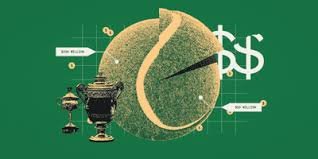Subtotal $0.00
In the fiercely competitive world of professional tennis, Grand Slam tournaments represent the pinnacle of achievement — both in prestige and prize money. Recently, the US Open 2025 made headlines by announcing a record-breaking \$85 million total prize purse, setting a new benchmark for player compensation in the sport. This announcement has reignited comparisons among the sport’s four Grand Slams: the Australian Open, the French Open (Roland-Garros), Wimbledon, and the US Open.
Let’s take a closer look at how these iconic tournaments stack up in terms of history, prestige, surface, prize money, and fan experience.
1. The Australian Open: The “Happy Slam”
- Location: Melbourne, Australia
- Surface: Hard Court (Plexicushion)
- Time of Year: January (Season Opener)
- 2025 Prize Money: Approx. \$81 million AUD (~\$54 million USD)

Nicknamed the “Happy Slam” for its player-friendly atmosphere and sunny Melbourne vibe, the Australian Open kicks off the tennis calendar. It was the first Slam to introduce final-set tiebreaks and embrace technology like electronic line calling on all courts. Though geographically distant for many players, it has steadily increased in prominence and now rivals its counterparts in prestige and prize distribution.
2. The French Open: Clay Court Conquerors’ Challenge
- Location: Paris, France
- Surface: Clay
- Time of Year: Late May – Early June
- 2025 Prize Money: Approx. €53 million (~\$58 million USD)
Known for its grueling rallies and demanding surface, Roland-Garros is the ultimate test of endurance and strategy. Clay slows down the ball and favors baseline players, making it a specialist’s domain. The tournament has lagged slightly in prize money growth compared to the others, but it’s catching up fast and remains an essential jewel in any player’s crown.
3. Wimbledon: Tennis Royalty
- Location: London, England
- Surface: Grass
- Time of Year: Early July
- 2025 Prize Money: Approx. £50 million (~\$64 million USD)
The oldest and arguably most prestigious of all, Wimbledon is the sport’s spiritual home. Known for its strict traditions — all-white dress code, no sponsor signage, royal attendance — it carries an aura that no other tournament can replicate. With its pristine grass courts and impeccable organization, Wimbledon maintains its place as the ultimate honor in tennis, even as the US Open begins to outpace it in financial terms.
4. US Open: Big Apple, Bigger Payout
- Location: New York City, USA
- Surface: Hard Court (DecoTurf)
- Time of Year: Late August – Early September
- 2025 Prize Money: \$85 million USD (Record-breaking)
Now officially the most lucrative Slam, the US Open continues to set standards in player compensation and entertainment. From night matches under the lights of Arthur Ashe Stadium to the vibrant atmosphere of NYC, the tournament embodies American showmanship. The 2025 prize money includes increased payouts for qualifying rounds, doubles teams, and early-round losers, reflecting the tournament’s growing emphasis on player equity.
Prize Money Comparison in 2025 (Approximate Totals):
| Grand Slam | Prize Money (USD) |
|---|---|
| US Open | \$85 million |
| Wimbledon | \$64 million |
| French Open | \$58 million |
| Australian Open | \$54 million |
The US Open now leads by a significant margin, reinforcing its dominance in financial generosity.
More Than Just Money
While the prize pool often grabs headlines, each Slam carries unique value. Players chase these titles not only for the paycheck but for their place in history. Career Grand Slams, Golden Slams, and legacy milestones are all rooted in these four tournaments.

- Rafael Nadal’s reign at Roland-Garros (14 titles) is seen as one of sport’s greatest feats.
- Roger Federer’s dominance at Wimbledon gave grass-court tennis its modern-day icon.
- Novak Djokovic’s record-breaking consistency across all surfaces makes him a Grand Slam force.
- Serena Williams’ US Open triumphs showcased her American legacy and crowd appeal.
Final Thoughts
The announcement of an \$85 million prize pool at the 2025 US Open is not just a financial milestone — it’s a symbolic statement about the future of tennis. As the sport evolves, with expanded draws, mixed events, and increasing emphasis on equity and technology, the Grand Slams remain at its core. Whether it’s the tradition of Wimbledon, the grit of Roland-Garros, the optimism of Melbourne, or the energy of New York, each Slam contributes a unique chapter to tennis’ ongoing story.
In the end, it’s not just about the money — it’s about the moment.













